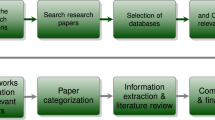Abstract
Many researchers are working hard in order to improve the capabilities of P2P networks. In this way, one of the main factors slowing down the improvement and development of P2P networks is the need to guarantee a minimum level of trust between two interacting nodes. This paper presents an innovative trust model providing a solution to this problem. Our trust model, which is based on the ant colony system, is able to select the best server to interact with, in terms of being the most trustworthy, in a very high percentage. Here, the traces of pheromone left by the ants correspond to the amount of trust that a node has on its neighbors.
Similar content being viewed by others
References
Almenárez, F., Marín, A., Campo, C., & García, C. (2004). PTM: A pervasive trust management model for dynamic open environments. In Privacy and trust. In Proceedings of the First Workshop on Pervasive Security, Privacy and Trust, PSPT’04. Boston, MA, USA.
Almenárez, F., Marín, A., Díaz, D., & Sánchez, J. (2006). Developing a model for trust management in pervasive devices. In Proceedings of the 4th Annual IEEE International Conference on Pervasive Computing and Communications Workshops.
Carbó J., Molina J.M., Dávila D. (2003) Trust management through fuzzy reputation. International Journal of Cooperative Information Systems 12: 135–155
Cordón O., Herrera F., Stützle T. (2002) A review on the ant colony optimization metaheuristic: Basis, models and new trends. Mathware and Soft Computing 9: 2–3
Dorigo M., Gambardella L.M. (1997) Ant colony system: A cooperative learning approach in the traveling salesman problem. IEEE Transaction on Evolutionary Computing 1(1): 53–66
Dorigo M., Maniezzo V., Colorni A. (1996) The ant system: Optimization by a colony of cooperating agents. IEEE Transactions on Systems, Man, and Cybernetics Part B: Cybernetics 26(1): 29–41
Huang, C., Hu, H., & Wang, Z. (2006). A dynamic trust model based on feedback control mechanism for P2P applications. In Autonomic and trusted computing (pp. 312–321). Berlin: Springer.
Marsh, S. P. (1994). Formalising trust as a computational concept. PhD thesis, Department of Computing Science and Mathematics, University of Stirling.
Marti S., Garcia-Molina H. (2006) Taxonomy of trust: Categorizing P2P reputation systems. Computer Networks 50(4): 472–484
Sabater, J., & Sierra, C. (2001). REGRET: Reputation in gregarious societies. In Proceedings of the Fifth International Conference on Autonomous Agents (pp. 194–195).
Sabater J., Sierra C. (2002) Social ReGreT, a reputation model based on social relations. SIGecom Exch 3(1): 44–56
Stützle T., Hoos H. (2000) MAX-MIN ant system. Future Generation Computer Systems 16(8): 889–914
Tajeddine, A., Kayssi, A., Chehab, A., & Artail, H. (2006). PATROL-F—A comprehensive reputation-based trust model with fuzzy subsystems. In Autonomic and trusted computing (pp. 205–217). Berlin: Springer.
Tang, Y., Sun, L., Luo, J., Yang, S., & Zhong, Y. (2006). TPOD: 2006A trust-based incentive mechanism for peer-to-peer live broadcasting. In Autonomic and trusted computing (pp. 332–341). Berlin: Springer.
Tian, H., Zou, H., Wang, W., & Cheng, S. (2006). A group based reputation system for P2P networks. In Autonomic and trusted computing (pp. 342–351). Berlin: Springer.
Wang, W., Zeng, G., & Yuan, L. (2006). Ant-based reputation evidence distribution in P2P networks. In Proceedings of the Fifth International Conference on Grid and Cooperative Computing (pp. 129–132).
Yu, F., Zhang, H., Yan, F., & Gao S. (2006). An improved global trust value computing method in P2P system. In Autonomic and trusted computing (pp. 258–267). Berlin: Springer.
Zacharia G., Maes P. (2000) Trust management through reputation mechanisms. Applied Artificial Intelligence 14: 881–907
Zhang, Y., Chen, H., & Wu Z. (2006). A social network-based trust model for the semantic web. In Autonomic and trusted computing(pp. 183–192). Berlin: Springer.
Zhuo T., Zhengding L., Kai L. (2006) Time-based dynamic trust model using ant colony algorithm. Wuhan University Journal of Natural Sciences 11(6): 1462–1466
Author information
Authors and Affiliations
Corresponding author
Rights and permissions
About this article
Cite this article
Gómez Mármol, F., Martínez Pérez, G. & Gómez Skarmeta, A.F. TACS, a Trust Model for P2P Networks. Wireless Pers Commun 51, 153–164 (2009). https://doi.org/10.1007/s11277-008-9596-9
Received:
Revised:
Accepted:
Published:
Issue Date:
DOI: https://doi.org/10.1007/s11277-008-9596-9




